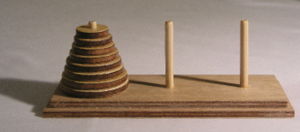Tower of Hanoi puzzle
From Psy3242
Revision as of 17:44, 27 April 2008 by Bchristian (Talk | contribs)
The Tower of Hanoi (similar to the Tower of London test) is a mathematical game or puzzle; it is used sometimes as a neuropsychological method to test executive functioning and is associated with the frontal lobes and prefrontal cortex. The Tower of Hanoi puzzle consists of three pegs, and a different number of varying sized disks which slide onto any peg. The puzzle starts with the disks neatly stacked in order of size on one peg, the smallest at the top, making a conical shape. The goal of the puzzle is to move the entire stack of disks to another peg.
Rules
- Only one disk may be moved at a time.
- No disk may be placed on top of a smaller disk.
Solution
(Example with 4 disks)
- Algorithm: Moves the smallest and non-smallest piece in alternating order. When moving the smallest piece, be consistent in moving it in the same direction (either left or right). If there is no tower in the chosen direction, move the smallest piece to the opposite end. When the turn is to move the non-smallest piece, there will only be one legal move to use.
- Keep practicing!
External Links
Play Tower of Hanoi


